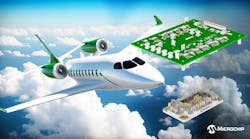EL SEGUNDO, Calif., 26 May 2005. Northrop Grumman Corp. is helping the U.S. Air Force develop propulsion technologies that could enable aircraft to routinely fly more than 1,500 miles per hour -- more than twice the speed of sound -- without the traditional drawbacks of supersonic flight.
Since the first supersonic flight nearly 60 years ago, aeronautical engineers have attempted to design an aircraft that could operate efficiently beyond the speed of sound. Barriers such as takeoff noise, sonic boom, engine wear and fuel consumption make supersonic aircraft expensive to operate and maintain.
The Air Force Research Laboratory's (AFRL) Versatile Affordable Advanced Turbine Engines (VAATE) program will develop and demonstrate advanced, multi-use turbine engine technologies to address these problems. Participants include elements of the U.S. Departments of Defense and Energy, NASA, and nine aerospace industry partners including Northrop Grumman.
For more information, see http://www.pr.afrl.af.mil/divisions/prt/vaate/vaate.htm.
"Today's information age requires that we act with speed, but aircraft have stalled in the subsonic regime," said Charles Boccadoro, director of Future Strike Systems for Northrop Grumman's Integrated Systems sector. "Under the VAATE program, Northrop Grumman will help demonstrate the key propulsion technologies that could break down those barriers."
Efficient supersonic flight would enable aircraft to conduct combat operations from bases far removed from target areas in as little as one third of the time. Military commanders could hold much larger areas at risk with fewer aircraft.
The key areas to be considered include thermal management systems, engine inlets and engine exhaust. Northrop Grumman and the other members of the VAATE program will assess the impact that such propulsion technologies would have on the affordability and performance of new turbine engines. They will also study the best ways to integrate these technologies with the airframe.
As part of this phase, Northrop Grumman will conduct an advanced engine study involving the Joint Unmanned Combat Air Systems (J-UCAS) program to identify better thrust and fuel-burning characteristics. Separately, Northrop Grumman is working on a $1.04 billion contract with the Defense Advanced Research Projects Agency (DARPA) for the operational assessment phase of the J-UCAS concept demonstration program.
This phase of the VAATE program is worth $5 million for Northrop Grumman. The overall indefinite delivery/indefinite quantity contract, which runs through 2011, has a potential value to the company of $20 million.
The VAATE program is another in a series of studies Northrop Grumman has conducted in support of its work in long-range strike technologies. These studies include the Air Force's Long Range Strike Aircraft, DARPA's Quiet Supersonic Platform program and the Shaped Sonic Boom Demonstration conducted with DARPA and NASA. In the Shaped Sonic Boom Demonstration program, a team led by Northrop Grumman demonstrated for the first time in flight that modifying an aircraft's shape can lower the intensity of its sonic boom. That 2003 event and subsequent test flights early the following year validated a technology that could lead to unrestricted supersonic flight over land.
Northrop Grumman Integrated Systems is a premier aerospace and defense systems integration organization. Headquartered in El Segundo, Calif., it designs, develops, produces and supports network-enabled integrated systems and subsystems optimized for use in networks. For its government and civil customers worldwide, Integrated Systems delivers best-value solutions, products and services that support military and homeland defense missions in the areas of intelligence, surveillance and reconnaissance; space access; battle management command and control; and integrated strike warfare. For more information, see www.northropgrumman.com.


